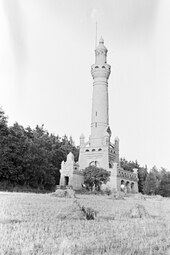Bismarck Tower (Weimar)
The Bismarck Tower near Weimar stood on the 480 meter high Ettersberg . With him, the city of Weimar and numerous places in the vicinity remembered Otto von Bismarck , the “blacksmith of German unity”. The tower was inaugurated in 1901 and blown up in 1949 for political reasons.
particularities
While many of the Bismarck towers were built exclusively from citizens' commitment, the situation was different for the tower near Weimar: On the one hand, the selected building site on Ettersberg was owned by Grand Duke Carl Alexander , who had to be won over for the project. On the other hand, the Grand Duchy under Grand Duke Wilhelm Ernst made a considerable contribution to the construction costs.
architecture
In terms of its shape, the building was rather untypical. The 43-meter-high tower was slim and resembled a minaret . It had a circumferential viewing platform at a height of 37 meters. Its sweeping substructure on the ground floor was somewhat reminiscent of the Kyffhäuser monument .
history
19th century
Since 1886 the Thuringian Forest Branch Association Weimar has been planning a lookout tower on the Ettersberg. The Grand Duke refused a request from the same year, also in 1896. In June 1899, the citizens' association committee for the erection of a Bismarck tower of honor on the Ettersberg near Weimar was established . The foundation stone for the highest Bismarck tower in Thuringia designed by Ernst Kriesche was laid on September 2, 1900.
20th century
The inauguration took place on October 27, 1901. The construction costs amounted to 27,000 marks . A special association was founded in 1902 to operate and maintain the Bismarck Tower.
Until the 1930s, the tower was a popular hiking destination for citizens in Weimar and the surrounding area and for tourists from near and far. The Bismarck Tower's undoing was that the Buchenwald concentration camp was built near it in the 1930s . Leading functionaries of the VVN were of the opinion in 1948 that the participants of the Buchenwald Day (= Buchenwald Memorial Day) would not understand “that the Bismarck memorial still towers over these graves”.
On April 22nd, 1949, the Small Secretariat , later the Secretariat of the Central Committee of the SED , headed by Walter Ulbricht, decided to blow up the Bismarck Tower on Ettersberg. Walter Bartel was informed of this decision - the city of Weimar, however, was not. On May 11, 1949, the tower was secretly blown up. In a file note from the Weimar State Building Authority on the same day, it says: “Despite detailed inquiries, we could not determine who carried out this demolition without our knowledge” .
literature
- Hartmut Stabe: Towers in the Grand Duchy of Saxony-Weimar-Eisenach. Discover, visit, hike. Weimar 2005, ISBN 3-930687-46-1 , pp. 107-131.
- Jörg Voigt: Blown up on the highest instructions? The fate of the Bismarck tower near Weimar . In: Werner Greiling , Hans-Werner Hahn (Ed.): Bismarck in Thuringia. Politics and culture of remembrance from a small-state perspective . Hain-Verl., Weimar, Jena 2003, ISBN 978-3-89807-046-1 , pp. 219-237.
Web links
- Bismarckturm Weimar at www.bismarcktuerme.de , accessed on December 21, 2013
- Repro at panoramio
Individual evidence
- ↑ Memorial instead of Bismarck Tower. The former Bismarck Tower in Weimar . Information from the Bismarck Towers website with references.
Coordinates: 51 ° 0 ′ 38.8 ″ N , 11 ° 15 ′ 31.6 ″ E
